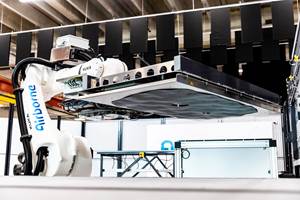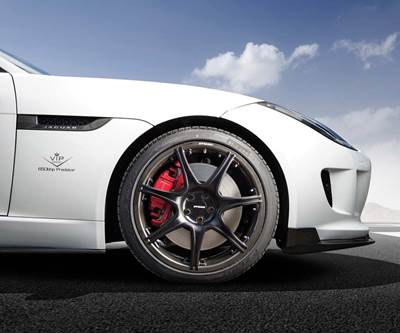One-piece, one-cure, infused carbon fiber wheel is ready to roll
ESE Carbon Co.’s new carbon fiber wheel uses tailored fiber placement and custom presses to minimize waste and improve scalability.
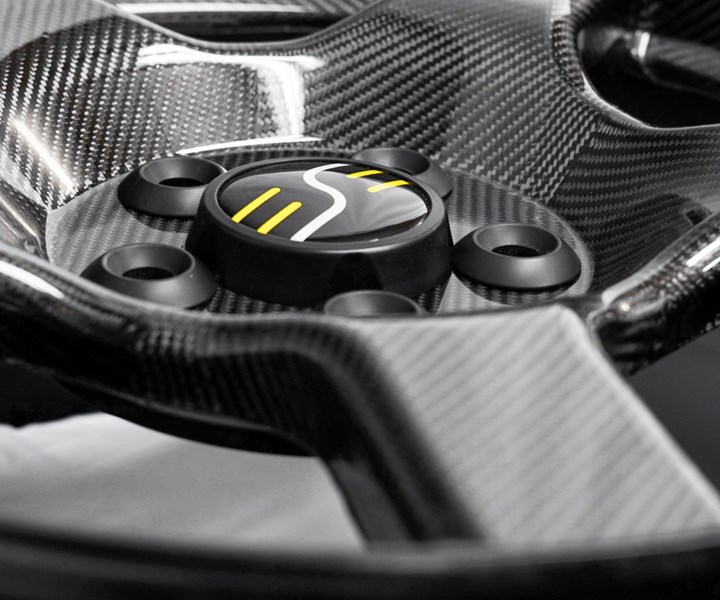
One-piece, one-cure. ESE’s E2 line of composite wheels uses tailored fiber placement (TFP) and a proprietary compression resin transfer molding (RTM) style process to produce a one-piece all carbon fiber wheel. Source | ESE Carbon Co.
Carbon fiber wheels offer a range of benefits by reducing rotational inertia and the combined mass — known as the unsprung mass — of a vehicle’s wheels, suspension and other directly connected components not supported by the suspension. This reduction in rotational inertia and unsprung mass, which can be as high as 50%, typically results in faster acceleration with less effort, reduced braking distance, improved handling due to better contact with the road (mechanical grip) and reduced road noise.
But the price tags on carbon fiber wheels — both hybrid and all-composite — have kept them out of reach of many consumers. With the most affordable priced at more than $10,000 for a set, the wheels are likely to only be found on very high-end sports cars and luxury vehicles. Several wheel companies, however, recognize the market potential for a lower-priced carbon fiber wheel and are working toward finding a solution. Approaches vary from the materials used to the way wheel components are manufactured and combined. Some combine carbon fiber components with aluminum for a hybrid wheel. Some create wheels from prepreg.
ESE Carbon Co. (ESE, Miami, Fla., U.S.) was founded in 2011 with the goal of making carbon fiber wheels available for a broader segment of the driving population. The company has added a five-axis CNC precision machining team, advanced structural composite parts capabilities, tailored fiber placement machines and robotics to automate production. The company aims to release its E2 line of one-piece, one-cure all carbon fiber composite automotive wheels in the coming year. Weighing only 17 pounds, ESE’s wheel is designed to a 3,850-pound axle rating, making it capable of supporting vehicles up to a 6,800 pound gross vehicle weight rating. According to ESE’s CEO Carlos Hermida, traditional aluminum wheels capable of handling the same weight would weigh more than 30 pounds.
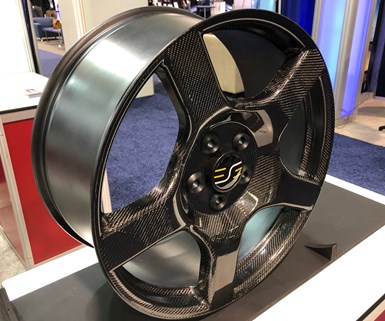
Deep bowl. The E2’s five-spoke design is based on a universal sport aesthetic. CW photo | Scott Francis
The E2 is a five-spoke design based on a universal sport aesthetic with a concave, deep bowl look. Hermida says the company was inspired by the design of an aluminum Porsche wheel, which was then optimized for carbon fiber. The wheel uses a high temperature epoxy system with good clarity and offers custom finish solutions including clear gloss, clear matte and custom colors.
ESE’s carbon fiber wheel is 80% of the way to certification under the existing Society of Automotive Engineers (SAE, Warrendale, Pa., U.S.) Recommended Practice, which applies to all wheels currently manufactured, including metallic wheels. What’s more, Hermida says the company is likely to have the first one-piece wheel on the market certified under a new composite wheel recommended practice, SAE J3204, which has just been approved for publication by the SAE. Like the metal wheel’s SAE recommended practice, this new recommendation for composite wheels addresses durability through various fatigue and impact tests. It also adds new requirements to account for environmental effects that are unique to composites. Dr. Michael Hayes, ESE’s vice president of product development, has been actively involved in the task force for this new recommended practice, sharing data and providing prototypes for developmental testing by the SAE committee. Internally, ESE’s engineering team is working to ensure that E2’s performance exceeds the minimum SAE recommendations. Years of prototype testing and physics-based simulation have led to the current E2 design.
“There have been years of work by the SAE task force to create the composite wheel practice,” says Hermida. “A lot of our testing data and knowledge has been shared with SAE to help get the practice to the finish line, and while the new SAE practice will be more rigorous than current wheel practices, we welcome it in the name of consumer safety.”
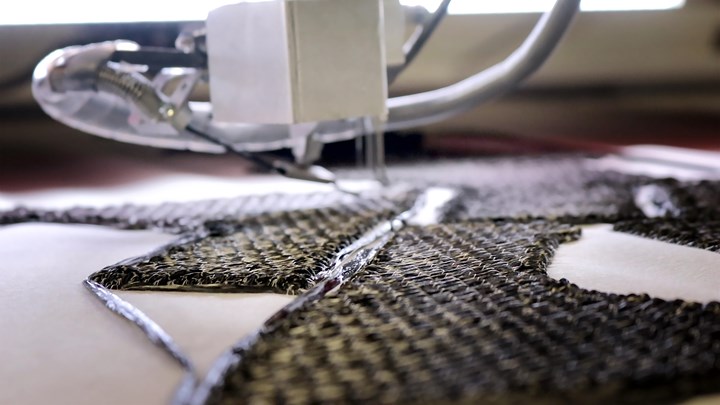
Tailored fiber placement. ESE’s carbon fiber wheel is created using ZSK Stickmaschinen GmbH’s tailored fiber placement technology (TFP). Source | ESE Carbon Co.
Turning to tailored fiber placement
ESE’s wheel is created using tailored fiber placement technology (TFP), which the company says allows fast-paced, high-volume manufacturing of carbon fiber components with good mechanical properties. TFP works by arranging fiber bundles, positioning them where they are needed for structural performance, and stitching them into position on a compatible base layer. The procedure is used in place of the conventional approach of cutting woven fabrics to a required shape. ESE uses industrial-grade carbon fiber tow from Hyosung Advanced Materials (Seoul, South Korea) and TFP technology from ZSK Stickmaschinen GmbH (ZSK, Krefeld, Germany) to stitch plies, creating preforms of near net shape.
“By controlling the path of the tow material as it is stitched into the desired geometry, material is only placed where it is needed in the final preform,” explains Topher Anderson Ph.D., manager of technical embroidery application for ZSK. “Areas of fabric that would have to be cut out in traditional laminate design are simply left unstitched. This process reduces both the initial waste produced when cutting woven fabrics to shape, and also reduces post processing waste due to the ability to conform to complex geometries.”
Originally working with traditional carbon fiber fabrics before transitioning to TFP, ESE claims the technology has allowed the company to reduce plies by up to 50%, thereby creating a simplified layup process and minimizing waste. According to Hermida, carbon fiber waste was reduced from around 40% with traditional carbon fiber fabrics to less than 10% by adopting TFP. In addition, the technology has led to improved layup quality, optimized fiber orientation and increased design flexibility.
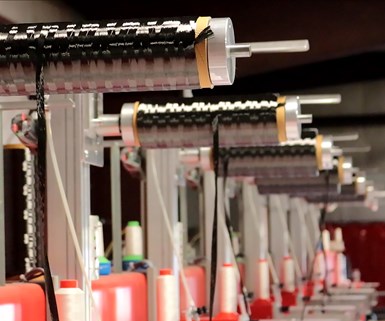
Aerospace grade tow. ESE uses carbon fiber tow from Hyosung Advanced Materials for the E2. Source | ESE Carbon Co.
“There’s a lot of curvature in our spokes, which complicates the plies. With traditional fabrics the orientation of your carbon fiber plies is limited,” explains Hermida. “With TFP, there is an almost unlimited ability to create straight or curved patterns in any direction, allowing you to design plies that are optimized to manage loads and stresses more effectively than possible with traditional fabrics.”
One of the most significant cost savings for ESE’s wheel comes from these layup improvements. Hermida says that prior to the switch to TFP, layup was a manufacturing bottleneck for the company. He claims the reduction in plies improves efficiency and reduces layup time by nearly 50%. More parts per mold can be made each day, which translates to a positive impact on overall investment of time, labor and equipment per wheel.
In all, ESE says TFP has simplified its process and contributed to improved scalability. Hermida says there is also an added cost advantage of consolidating the supply chain by purchasing tow as opposed to fabric.
All-infused, one-cure carbon fiber wheel
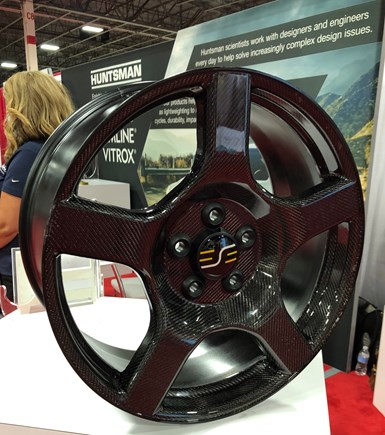
Braking heat. ESE Carbon says Huntsman’s Araldite has improved production rates and increased rim strength, even at the elevated temperatures to which wheels are exposed during braking. CW photo | Scott Francis
In addition to its investment in TFP technology, ESE is moving away from autoclave processing for its wheel as it pushes for improved production rates. The E2 is produced by a proprietary compression resin transfer molding (RTM) process using custom presses designed by ESE’s engineering team. Hermida says achieving an all-infused, one-cure wheel was challenging. A key component of this was selecting the right resin system.
“We needed a low-viscosity, high Tg [glass transition temperature], high-clarity, fast-curing system with robust properties,” says Hermida.
The company selected Huntsman Advanced Materials’ (The Woodlands, Texas, U.S.) Araldite for its epoxy resin system. According to Huntsman, the system offers low viscosity for faster injection speeds, fiber wet out and ease of processing, as well as flexibility to adjust to different mold conditions and cycle times. With Araldite, ESE says it is able to enhance production rate and increase the rim strength, even at elevated temperatures to which wheels are exposed during braking.
Araldite combines improved elongation and higher fracture toughness when comparet to conventional epoxy resins with high Tg up to 200°C.
“Because of brake heat that’s generated, that’s a critical component,” says Hermida.
To reduce time in the mold, the system offers cure at intermediate temperatures within the mold, followed by optional post-cure at elevated temperatures outside the mold. The result is a lightweight composite rim with good fatigue resistance, which is key to durability in wheels that are exposed to repeated cycling/stresses during vehicle operation.
Huntsman technical representatives worked with ESE’s engineering team to determine which epoxy resin system would fit their production needs, as well as the ideal component ratios to attain a work life long enough for injecting multiple wheel molds before the epoxy begins to gel. In addition, the company provided computer-generated, predictive cure modeling analysis and laboratory testing to help support ESE’s development efforts.
The composite wheel keeps on turning
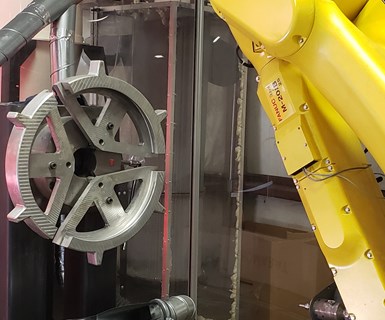
Automation. ESE is working to advance its automation of such tasks as trimming, pick and place automation and preforming. Source | ESE Carbon Co.
ESE will begin road testing in Q1 2020. Delivery of aftermarket wheels is expected later in 2020 and ESE says it has begun discussions with OEMs. With the E2 poised for its debut on the market, the question comes back to cost. Most of the carbon fiber wheels on the market today are approximately the cost of some affordable cars.
“Carbon fiber wheel manufacturing is unique in many ways; while current automation technologies benefit us, a large amount of customization and development of automation is still required to get to the wheel price points we want,” says Hermida.
With its addition of TFP, ESE is making strides in the automation of its process. Hermida says the company has also been able to automate post-processing of the wheel, and the company is currently working to advance its automation of such tasks as trimming, robotic pick and place layup and preforming.
“It comes down to ESE making carbon fiber wheels attainable,” says Daniel Canavan, ESE’s vice president of business development. “We are diligently working to reach a point where carbon fiber technologies can be applied to the greater populous.”
ESE’s E2 aims to be more than just a competitive wheel on the market. The initial goal is to offer a set of four wheels for less than $9,900. While this may still sound expensive, it’s definitely a step in the right direction, and Hermida says the company’s automation projects will help trim the costs to reach beyond the luxury/performance market.
“Our ambitions go way beyond that,” says Hermida. “This is just a starting point. Our goal is to set prices that are within striking distance of forged aluminum wheels.” Comparable forged aluminum wheels range between $5,000-$7,000.
“We see a bigger picture of doing this in mass production,” says Canavan. “We’re thinking of electric vehicles and other markets where we can share efficiency and [users] can experience the benefits of unsprung weight — performance, speed and safety. There are so many advantages to this technology where we can truly make a difference.”
Related Content
From the CW Archives: Fast-cure epoxies for automotive fabrication
Sara Black’s 2015 report on the development of snap-cure epoxies for automotive manufacturing still resonates today.
Read MoreModular, robotic cells enable high-rate RTM using any material format
Airborne’s automated ply placement systems at Airbus, GKN Aerospace and Teijin Automotive Technologies aim to maximize flexibility and intelligent automation.
Read MorePlant tour: Aernnova Composites, Toledo and Illescas, Spain
RTM and ATL/AFP high-rate production sites feature this composites and engineering leader’s continued push for excellence and innovation for future airframes.
Read MoreMcClarin Composites partners with ExxonMobil to accelerate high-speed RTM
Multimillion-dollar investment to drive next-gen automated RTM technology will open new applications and markets for composites OEMs.
Read MoreRead Next
Carbon fiber has designs on production wheels
A high-performance CFRP wheel manufacturer for nearly 20 years, Dymag is now part of a broader effort to reduce their cost and migrate them into volume vehicles.
Read More“Structured air” TPS safeguards composite structures
Powered by an 85% air/15% pure polyimide aerogel, Blueshift’s novel material system protects structures during transient thermal events from -200°C to beyond 2400°C for rockets, battery boxes and more.
Read MoreVIDEO: High-volume processing for fiberglass components
Cannon Ergos, a company specializing in high-ton presses and equipment for composites fabrication and plastics processing, displayed automotive and industrial components at CAMX 2024.
Read More
















